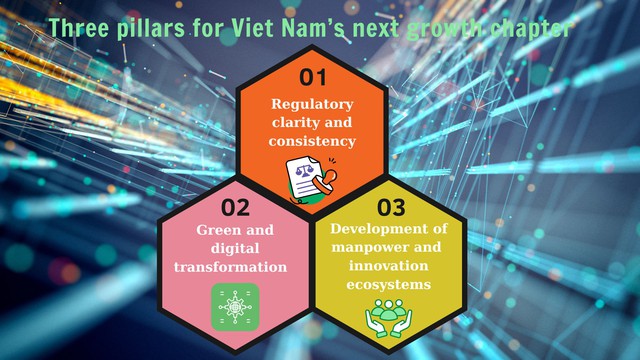Viet Nam seen as a long-term strategic base for the region
VGP - Viet Nam is not aiming to compete on cost but on quality and sustainability. Many new investors are looking beyond any single market and they see Viet Nam as a long-term strategic base for the region, said Chairman of EuroCham Viet Nam Bruno Jaspaert.

Chairman of EuroCham Viet Nam Bruno Jaspaert
Viet Nam is steadily rising
Viet Nam's development story in the 2021–2026 period is one of remarkable resilience. Emerging from a period of global uncertainty, the country has charted one of the strongest growth trajectories in Asia while balancing short-term stability with long-term transformation.
What stands out to me most is not just the numbers, but the direction. Viet Nam is not aiming to compete on cost; it aims to compete on quality and sustainability. The country is modernizing its logistics networks, strengthening clean energy capacity, and gradually integrating ESG standards into industrial policy. These are not easy shifts – but they show the determination of a country moving from rapid growth to resilient growth.
The Q3 2025 Business Confidence Index reinforces this optimism: confidence among European firms has climbed to its highest level in three years, and 76% of businesses leaders would recommend this country as an investment destination. That is a powerful vote of confidence from investors who have weathered global shocks and still see Viet Nam as one of Asia's most dynamic investment frontiers.
"At recent EuroCham Viet Nam events, I was asked whether the government should revise its 8 percent GDP growth target in light of the new U.S. tariff policy. My answer was simple: there is no reason to lower it," Bruno Jaspaert said.
Viet Nam's economy would likely have exceeded that target even without the tariffs. This country is among the most resilient I have ever worked in. Public debt remains under control, allowing room for infrastructure investment that can lift GDP growth by one or two percentage points on its own. And many new investors are looking beyond any single market – they see Viet Nam as a long-term strategic base for the region.
Just look at the numbers: the IMF and World Bank recently raised their 2025 growth forecasts to 6.9 percent, and HSBC now projects 7.9 percent. Viet Nam is steadily rising – there is no doubts.

Resilient and responsive Government in navigating changing global economy
From the perspective of European investors, Viet Nam's government has demonstrated both resilience and responsiveness in navigating a rapidly changing global economy.
Over the past few years, we have seen strong and visible efforts to simplify administrative procedures, accelerate infrastructure development, and improve the business climate. The recent reforms to visa and work-permit regulations, for example, have been widely recognised by our members as practical and meaningful – nearly half of surveyed firms in our latest BCI report noted positive changes in the last quarter alone. These are precisely the types of improvements that strengthen confidence and signal Viet Nam's readiness to compete for high-quality investment.
European investors also appreciate the Government's forward-looking stance on sustainability, digitalisation, and trade facilitation. Viet Nam's public administration has shown increasing openness to dialogue and partnership with the private sector – and EuroCham is proud to be one of its closest partners in that process.
A key highlight this year was the visit of EU Commissioner for Trade and Economic Security, Maros Sefcovic, to Ha Noi in late September. During our high-level dialogue with the Commissioner, we discussed the progress and the practical challenges faced by European enterprises operating in Viet Nam. What impressed me most was the shared spirit of problem-solving from both sides. Viet Nam and the EU agreed to create joint taskforces to ensure that structural bottlenecks are addressed swiftly and systematically. This marks a very concrete step forward, showing that our partnership is not just about dialogue but also about delivery.
In essence, the Vietnamese Government's performance has evolved from policy design to policy execution – with a growing focus on accountability, transparency, and results. Of course, challenges remain, such as inconsistent enforcement at the provincial level or the need for clearer renewable energy and land-use frameworks. But there is a genuine sense of progress and determination to address these issues.
As someone who has lived and worked here for eight years, I have witnessed this first-hand. The Government's openness to consultation, combined with the dynamism of Viet Nam's people, is what keeps investors here – not just for one project cycle, but for the long run. And as our recent Business Confidence Index shows, 80 percent of European firms express optimism in the 5-year outlook of Viet Nam. That speaks volumes about trust – and trust, in the end, is the foundation of every successful partnership.

Three pillars for Viet Nam's next growth chapter
Viet Nam's next growth chapter will depend on how effectively it links economic ambition with sustainability, innovation, and inclusiveness. From EuroCham's perspective, three pillars stand out as essential.
First, regulatory clarity and consistency. Predictable, transparent, and evenly enforced policies – particularly around energy access, taxation, customs, and digitalization – will not only reduce business costs but also unlock new waves of high-quality investment. A unified implementation and guidance across provinces will allow both European and Vietnamese firms to plan with confidence.
Second, green and digital transformation must now accelerate from pilot projects to national scale. Viet Nam already has a powerful foundation: through the EU's Global Gateway and the Just Energy Transition Partnership (JETP), 24 green projects worth roughly US$7 billion are being considered. This momentum should now extend to circular economy initiatives, renewable grid upgrades, and digital product passports – all vital to align with evolving global standards such as the EU's EUDR and ESPR.
Third, human capital and innovation ecosystems. Viet Nam's most valuable resource remains its people. Developing skilled engineers, data specialists, and sustainability professionals will ensure that investment in green and digital sectors creates lasting local value. Stronger public-private partnerships for vocational training and research can accelerate this transition.
EuroCham sees Viet Nam's transformation not just as an economic story, but as a collective mission. That is why our flagship Green Economy Forum (GEF) 2025, taking place on 27 November in Ha Noi, is dedicated to the theme "Shaping Changes – Building Futures." It will convene policymakers, business leaders, innovators, and youth to exchange ideas on how Viet Nam can achieve rapid, sustainable, and inclusive growth.
The Chairman took the occasion to warmly invite everyone – from industry, government, and academia – to join us at GEF 2025. "Together, we can ensure Viet Nam not only grows faster, but grows greener and wiser, setting a benchmark for sustainable development across the region," he finalized./.

